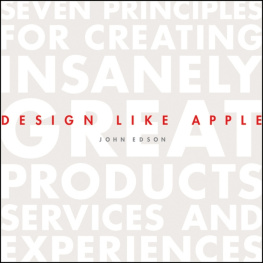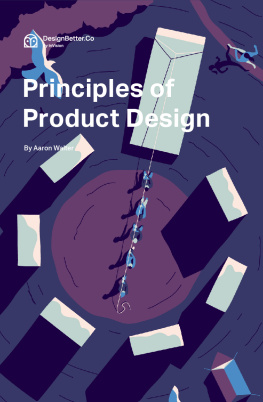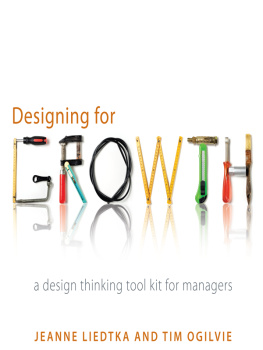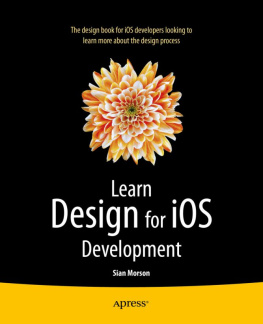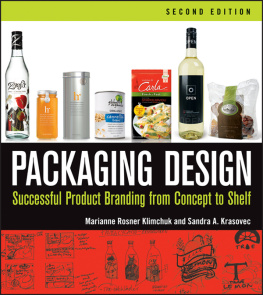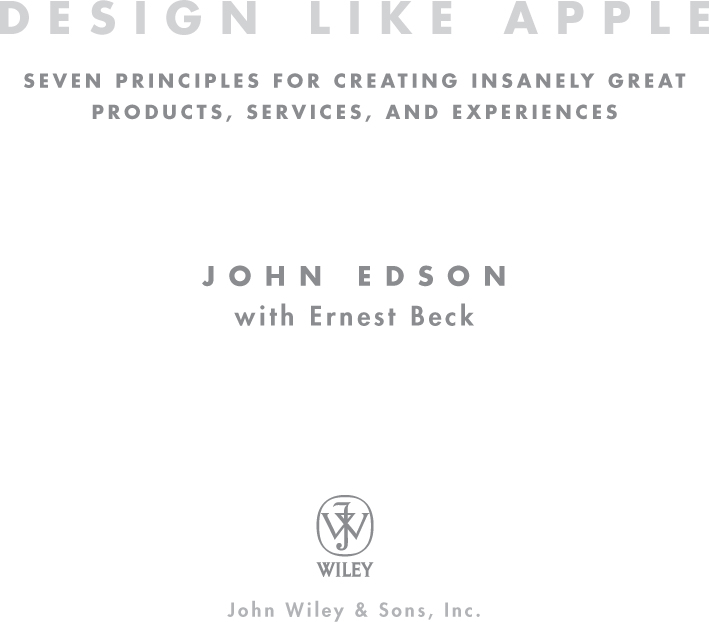Copyright 2012 by LUNAR Design, Incorporated. All rights reserved.
Published by John Wiley & Sons, Inc., Hoboken, New Jersey. Published simultaneously in Canada
No part of this publication may be reproduced, stored in a retrieval system, or transmitted in any form or by any means, electronic, mechanical, photocopying, recording, scanning, or otherwise, except as permitted under Section 107 or 108 of the 1976 United States Copyright Act, without either the prior written permission of the Publisher or authorization through payment of the appropriate per-copy fee to the Copyright Clearance Center, Inc., 222 Rosewood Drive, Danvers, MA 01923, (978) 750-8400, fax (978) 646-8600, or on the web at www.copyright.com. Requests to the Publisher for permission should be addressed to the Permissions Department, John Wiley & Sons, Inc., 111 River Street, Hoboken, NJ 07030, (201) 748-6011, fax (201) 748-6008, or online at http://www.wiley.com/go/permissions.
Limit of Liability/Disclaimer of Warranty: While the publisher and author have used their best efforts in preparing this book, they make no representations or warranties with respect to the accuracy or completeness of the contents of this book and specifically disclaim any implied warranties of merchantability or fitness for a particular purpose. No warranty may be created or extended by sales representatives or written sales materials. The advice and strategies contained herein may not be suitable for your situation. You should consult with a professional where appropriate. Neither the publisher nor author shall be liable for any loss of profit or any other commercial damages, including but not limited to special, incidental, consequential, or other damages.
For general information on our other products and services or for technical support, please contact our Customer Care Department within the United States at (800) 762-2974, outside the United States at (317) 572-3993 or fax (317) 572-4002.
Wiley publishes in a variety of print and electronic formats and by print-on-demand. Some material included with standard print versions of this book may not be included in e-books or in print-on-demand. If this book refers to media such as a CD or DVD that is not included in the version you purchased, you may download this material at http://booksupport.wiley.com. For more information about Wiley products, visit www.wiley.com.
ISBN: 978-1-118-29031-6 (cloth)
ISBN: 978-1-118-33176-7 (ebk)
ISBN: 978-1-118-33396-9 (ebk)
ISBN: 978-1-118-33507-9 (ebk)
To the memory of an insanely great family Robert, Ana-Maria, Samantha, and Veronica
Acknowledgments
The principal source for what I know about design comes from an exceptionally fortunate career that I have had at LUNAR working alongside some of the most amazingly creative and brilliant people in the world of product development. Jeff Smith and Gerard Furbershaw founded and built a singular firm that is as amazing for its creative output as it is for its ability to retain employees. Few companies engender the kind of loyalty that LUNAR does, thanks to the commitment of Jeff and Gerard to an organization that values people and relationships as much as creative excellence and financial performance. I have worked for and with them for two amazing decades. Thanks, guys, for a company worth the years.
Jeff Smith also deserves credit for articulating the beautyingenuitycharisma framework that I write about in this book, with input and help from many superb contributors, including Prasad Kaipa, Jeff Salazar, Ken Wood, Becky Brown, Nirmal Sethia, Roman Gebhard, Matthis Hamann, and me.
My thanks to the crew of early Apple employees who helped me reconstruct the formative days of the company and the genesis of the Apple design culture: Randy Battat, Mike Looney, Clement Mok, Joy Mountford, Larry Tesler, and John Zeisler. Special thanks to Bill Dresselhaus, one of the first product designers at Apple and a client and colleague, for his help in this effort and his interest in me and my career over the years. Many people helped me understand the design process and culture of design at Apple in more recent years, including Tony Fadell and a number of others who asked to remain anonymous.
Thanks to Josh Handy at Method Products and to Albert Shum at Microsoft for your openness in discussing what design means to your companies. Uday Dandavate helped inform and expand the ideas about design research. Thanks to John Paul for the rich discussion on managing functionality, quality, and schedule and to Ken Wood, Misha Cornes, and Nathan Shedroff for helping me frame this book and encouraging ideas along the way. Thanks to Helen Walters for motivating me to tackle this project in the first place.
This beautiful book would not have been possible without my colleagues at LUNAR who created the outstanding design, led by art director Kenny Hopper and book designer Mary Shadley. Thanks to Kevin Wong who devised the cover art concept, and to designers Anna Kwon and Gritchelle Fallesgon for collecting and creating imagery used throughout the book, and to Carly Lane and Jonathan Cofer for the design of the project website. Danielle Guttman was invaluable in researching and coordinating a surprising array of logistics.
My writing partner, Ernest Beck, has been a crucial critic during the prototyping and refinement of this book, an optimistic guide when I've had my moments of panic, and a tolerant colleague during my eleventh hour obsessing. Thanks. And much gratitude goes to Richard Narramore and the consummate professionals at John Wiley & Sons, Inc., who entrusted me with this book and remained patient throughout the process.
To my family, friends, and colleagues, thank you for tolerating my absences, both physical and emotional, during the many hours of devotion to this project. Everyone at LUNAR has been extraordinarily supportive while carrying the extra loadand some have gone the extra mile.
Thanks to Mark Dziersk for stepping into my empty shoes and for reading the manuscript. Erik Hansen deserves a shout-out for the many years of friendship through a number of life challenges and achievements, including this project. Special thanks go to Frank and Terry for your persistent support.
This book would not have been possible without my family. For taking up the slack and for believing deeply in me, my wife and best friend, Megan, deserves the lion's share of credit and recognition for this book. I love you. Jack, for your bottomless stores of playful creativity, and Olivia, for your commitment to living life largeyou are my muses and inspiration. May you each find and embrace your own creative spirit throughout your lives. And finally, thanks go to my parents for their encouragement of me to do the same.
Introduction
Apple, design, and Steve Jobs.
It's safe to say that you have probably had a firsthand experience with an Apple product or serviceand that you have had a deeper experience over the past three decades with a succession of products created by one of the world's most valuable companies. It's also safe to say that you have visited an Apple Storemany times perhaps, to buy or browse or just to gawk in wonderor have logged onto the Apple website.
If you're like many people, you talk about the product, whether a Mac, an iPod, an iPhone, or an iPad, and the experience with Apple itself as if they were an important relationship. There is a reason for that.
The iPhone 4S brought voice recognition and smarts to life through Sirianother Apple innovation that makes technology feel more human.

